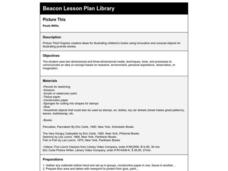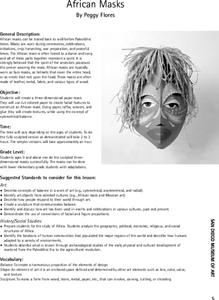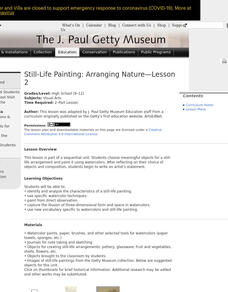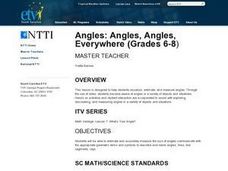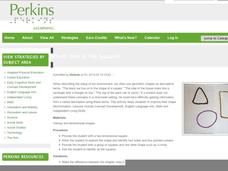Curated OER
Shapes Around Us
Pupils identify basic two-dimensional shapes. They are able to identify the four basic two-dimensional shapes: squares, rectangles, triangles, and circles. Students write/draw in their learning logs a reflection of what they noticed...
Curated OER
Measures of Space I: Lengths and Areas
Pupils discover how to measure in one and two dimensional space and calculate how much space any object of a given dimension occupies. After a discussion about dimensions, students work with Zome System Creator Kits to build one and two...
Curated OER
Combining Geography and Literature by Mapping a Story
Students listen to or read a story on their own. Using the text, they describe the relative locations of the main events. In groups, they develop two and three dimensional maps of the story. They create a key and a title for their map.
Curated OER
Creating Space
Learners use simple lines and shapes to draw objects, figures, or animals.They explore the process of printmaking and making multiples, use repetition of simple shapes to create complex images, and inquire about a contemporary artist's...
Curated OER
Foil Fun
Second graders be having hands-on experiences with three-dimensional solid shapes. They investigate the features of solid shapes and examine the names for them. They are introduced to making nets for 3D shapes.
Curated OER
Picture This
Fourth graders use two-dimensional and three-dimensional media, techniques, tools, and processes to communicate an idea or concept based on research, environment, personal experience, observation, or imagination.
Curated OER
Down on the Farm
Learners are introduced to a map of an Illinois farm. They determine whether the map is of the past, present, or future by looking at features on the map. They also use the map to make a three-dimensional model.
Curated OER
African Masks
Fourth graders create three-dimensional paper African masks. They analyze the geographic, political, economic, religious, and social structures of Africa. they discover that masks were worn for various ceremonies.
Curated OER
The Next Dimension
Students explore the three dimensional Cartesian coordinate system and discuss how it is important for structural engineers in order to be able to describe locations in space to fellow engineers. They participate in a hands-on activity...
Curated OER
Geometric Figures
Students identify two and three dimensional shapes and use appropriate geometric vocabulary to write a description of the figure by taking pictures of geometric figures in their own environment.
Curated OER
Classification
Young scholars explore the observable properties of matter and utilize them in classification. They use a binary classification system to divide objects, then justify their scheme.
Curated OER
The Castle
Students build a castle to Ravi's design using the cubes. Students then make an original model of a solid object from diagrams which show views from the top, front, side and back. Students describe the reflection of rotational symmetry...
Creative Educator
Dream Room Design
Using the Twist™ application, elementary schoolers design their dream room. They follow the prescribed steps to calculate width, length, perimeter, and surface area in order to create a 2-dimensional representation of their dream room...
Curated OER
Still-Life Painting: Arranging Nature—Lesson 2
Learners choose meaningful objects for a still-life arrangement and paint it using watercolors. After reflecting on their choice of objects and composition, students begin to write an artist's statement.
Curated OER
Angles: Angles, Angles, Everywhere
Students practice estiminating and measuring angles. After watching a short video, they identify angles in objects in the classroom and their homes. In groups, they participate in activities in which they are given a scenerio and are...
Curated OER
Expressive Hands with Stippling Value Shading
Students create a larger than life modified contour drawing of hands in an expressive situation. Hands have linear value, contain a object, and have a patterned background.
Curated OER
Making Models of Atoms and Isotopes
In this models of atoms and isotopes worksheet, students use marshmallow of different colors to represent the protons, neutrons and electrons in an atom. Students make models of the 3 isotopes of hydrogen. They draw a diagram of each and...
Curated OER
An application of the Parallax Effect
In this parallax effect activity, students observe 2 photographs taken of an active area of the sun by 2 STEREO satellites and 1 photograph taken of the same active area of the sun by the SOHO satellite. Students observe the shift in...
Pennsylvania Department of Education
Creating Polygons
Students describe, make and compare polygons. For this creating polygons lesson, students identify properties of quadrilaterals and describe common features of two dimensional shapes.
Curated OER
Impact on Your Essence
Students are introduced to the use of symbolism and how it can change one's view of a piece of art. Using a piece of art, they view it as if they were the artist and create a symbol that accompanies it. They discuss the impact of two-...
Curated OER
Dimensional Space: Various Perspectives
Students use their understanding of 3D on 2D to make a representation of a 4D form on paper.
Perkins School for the Blind
Which One is the Square?
Children who are blind need to constantly be engaged in building conceptual understandings of the world around them. This activity will help them grasp the concept of shape, identify shapes, and consider shapes as they are used to...
J. Paul Getty Trust
Still-Life Painting: Arranging Nature—Lesson 1
Art learners examine still-life arrangement images and respond to a series of prompts. In a whole-class discussion, pupils list elements and qualities that still-life paintings can have. After instructors create an arrangement and model...
McGraw Hill
The Units of the English System
Go from feet to inches to yards and back again with this notes and learning exercise combo resource. Several pages of examples regarding unit conversion of the English system are given, followed by different pages of problems. There is a...





